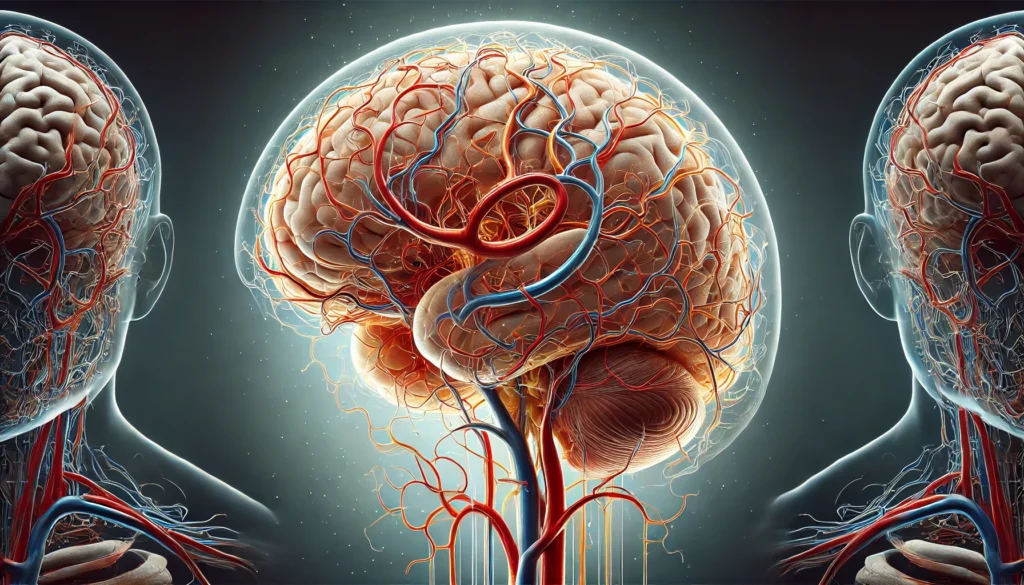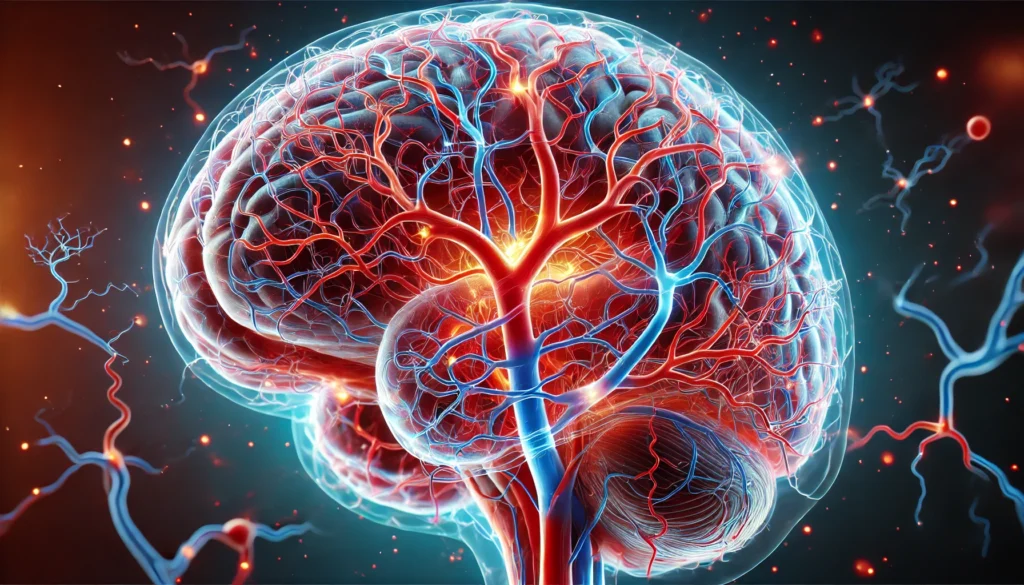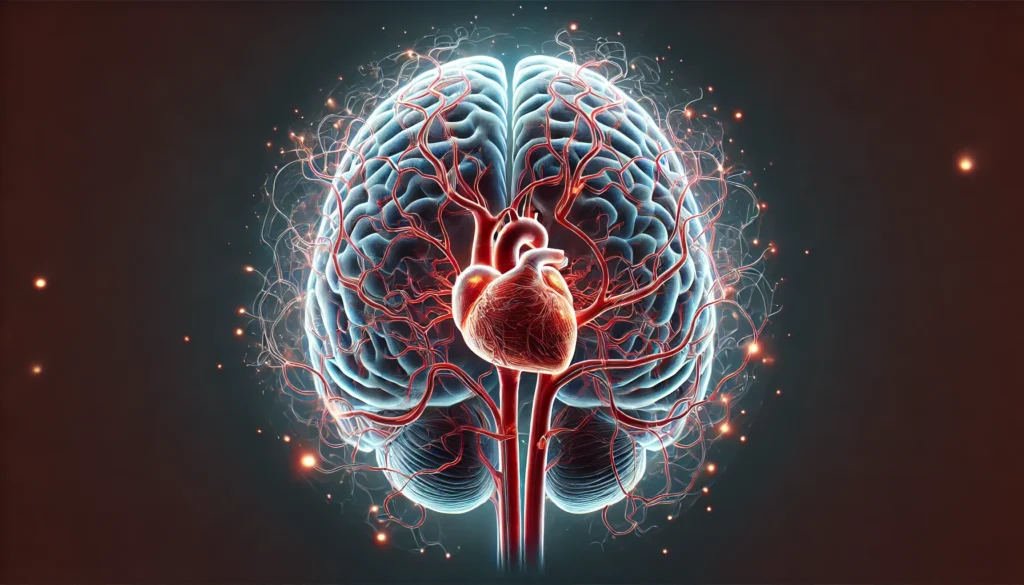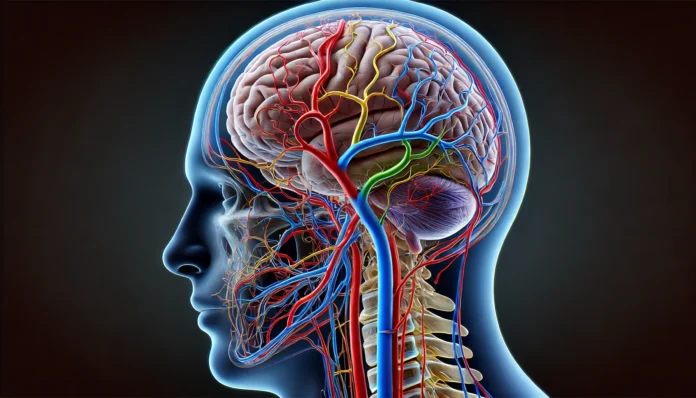The human brain is an intricate and highly specialized organ, requiring a continuous and robust supply of oxygen-rich blood to function optimally. The vast network of blood vessels that permeates the brain ensures its nourishment, supporting cognitive abilities, memory, and overall neurological health. Understanding the anatomy of brain vessels is critical for medical professionals, researchers, and even individuals invested in maintaining cognitive longevity. This exploration will provide a deep dive into the structure, function, and significance of the brain’s vascular system, along with an in-depth analysis of a brain artery diagram that offers a visual representation of these critical pathways.
You may also like : Best Things for Brain Health: Expert-Backed Strategies to Keep Your Mind Sharp
The Importance of Brain Vascular Health
Brain health is intrinsically tied to the efficiency and integrity of its vascular network. The brain’s arteries are responsible for delivering oxygen and nutrients, and any compromise in these structures can lead to severe consequences, including strokes, cognitive decline, and neurodegenerative diseases such as Alzheimer’s. Research has consistently shown that vascular health plays a pivotal role in maintaining cognitive function throughout aging. Reduced blood flow to the brain can result in hypoxia, a condition in which the brain does not receive adequate oxygen, leading to neuron damage and cognitive impairment. By understanding the anatomy of brain vessels, we can better appreciate how lifestyle choices, medical interventions, and preventative care contribute to long-term brain health.
An Overview of the Brain’s Vascular System
The brain’s vascular system is primarily composed of arteries, veins, and capillaries. The arterial system is of particular importance as it carries oxygenated blood from the heart to the brain. The major arteries supplying the brain include the internal carotid arteries and the vertebral arteries, which converge to form the Circle of Willis—a crucial anastomotic structure that ensures a consistent blood supply even if one pathway is blocked or narrowed.
The internal carotid arteries bifurcate into the anterior cerebral artery and middle cerebral artery, while the vertebral arteries merge to form the basilar artery, which then gives rise to the posterior cerebral arteries. These arteries branch into smaller arterioles and capillaries, ensuring blood reaches even the most minute neural structures. Understanding this intricate network through a brain artery diagram provides insight into how different brain regions receive nourishment and why certain vascular pathologies disproportionately affect specific cognitive functions.
The Circle of Willis: A Critical Arterial Network
The Circle of Willis is one of the most significant features of the brain’s arterial system. It serves as a protective mechanism, allowing collateral circulation in cases where one or more arteries become occluded. This structure is composed of the anterior cerebral arteries, anterior communicating artery, internal carotid arteries, posterior cerebral arteries, and posterior communicating arteries. This redundant circulation helps prevent ischemic events and ensures a steady blood flow even under conditions of arterial narrowing or blockage.
However, variations in the Circle of Willis are common, and in some individuals, this network is incomplete, increasing their susceptibility to cerebrovascular diseases. A detailed examination of the brain artery diagram reveals these anatomical variations and their potential implications. Clinicians rely on imaging techniques such as magnetic resonance angiography (MRA) and computed tomography angiography (CTA) to visualize these structures in patients, aiding in the diagnosis and management of vascular-related conditions.

Common Disorders Affecting Brain Arteries
Several medical conditions impact the anatomy of brain vessels, leading to cognitive and neurological impairments. One of the most concerning disorders is atherosclerosis, a condition characterized by the buildup of plaque within arterial walls. This process narrows the arteries, reducing cerebral blood flow and increasing the risk of stroke.
Stroke, whether ischemic or hemorrhagic, is another major concern associated with cerebral arteries. Ischemic stroke occurs due to a blockage in an artery, while hemorrhagic stroke results from the rupture of a weakened arterial wall. Aneurysms, another vascular disorder, are characterized by abnormal bulging of arterial walls, which may rupture and cause life-threatening hemorrhage.
Cerebral small vessel disease (CSVD) is a condition that affects the smaller arterioles and capillaries, leading to chronic ischemia and contributing to vascular dementia. Research has highlighted the link between CSVD and cognitive decline, underscoring the importance of maintaining vascular health for cognitive longevity.
Strategies for Maintaining Brain Vascular Health
Maintaining the integrity of the brain’s vascular system is essential for cognitive enhancement and longevity. Lifestyle modifications, including a balanced diet, regular exercise, and blood pressure management, play a crucial role in preventing vascular damage. A diet rich in antioxidants, healthy fats, and fiber helps reduce inflammation and supports arterial health. Regular physical activity enhances circulation, promoting oxygen and nutrient delivery to the brain.
Managing chronic conditions such as hypertension, diabetes, and hyperlipidemia is also fundamental in preserving vascular health. These conditions contribute to endothelial dysfunction, which impairs the brain’s arterial system and increases the risk of cognitive decline. Medical advancements, including pharmacological interventions and emerging regenerative therapies, continue to offer promising avenues for enhancing vascular health and mitigating age-related cognitive decline.
The Future of Brain Vascular Research
Ongoing research in the field of neurovascular health is shedding new light on strategies to enhance cerebral circulation and prevent vascular-related cognitive impairments. Advances in imaging technologies are allowing researchers to map the brain’s vasculature with greater precision, leading to earlier detection and better management of cerebrovascular diseases. Furthermore, novel therapeutic approaches, including stem cell therapy and gene editing, are being explored for their potential to repair damaged blood vessels and restore cognitive function.
As the field of neuroscience continues to evolve, a deeper understanding of the anatomy of brain vessels will play a critical role in shaping interventions for cognitive enhancement and longevity. The integration of artificial intelligence in medical imaging and diagnostics is also paving the way for more personalized and precise treatments.

Frequently Asked Questions: Understanding the Anatomy of Brain Vessels
1. How does the anatomy of brain vessels impact cognitive function?
The anatomy of brain vessels plays a critical role in maintaining cognitive function by ensuring adequate oxygen and nutrient delivery to neurons. Disruptions in cerebral blood flow can result in hypoxia, which impairs memory, concentration, and problem-solving skills. The brain’s intricate network of arteries, arterioles, and capillaries must function optimally to support neuroplasticity—the brain’s ability to adapt and form new connections. Reduced cerebral circulation has been linked to conditions such as vascular dementia and Alzheimer’s disease, highlighting the need for vascular health maintenance. By analyzing a brain artery diagram, researchers can better understand the relationship between cerebrovascular structure and cognitive performance, leading to improved treatment strategies.
2. What makes the Circle of Willis so important for brain health?
The Circle of Willis is a crucial arterial network that provides redundancy in cerebral circulation, ensuring that the brain remains perfused even if one pathway becomes compromised. This interconnected loop of arteries allows for collateral blood flow, reducing the risk of ischemic injury due to blockages or arterial narrowing. However, variations in the Circle of Willis exist among individuals, with some having incomplete or asymmetrical structures, increasing their susceptibility to stroke. Understanding the anatomy of brain vessels, particularly the Circle of Willis, helps neurologists predict an individual’s risk for cerebrovascular diseases. Advanced imaging techniques, such as MR angiography, allow for precise mapping of these structures and early intervention in cases of abnormal vascular configurations.
3. How does high blood pressure affect the brain’s arteries?
High blood pressure exerts excessive force on the brain’s arteries, leading to endothelial damage and increasing the risk of aneurysms, strokes, and cognitive decline. Chronic hypertension accelerates arteriosclerosis, where artery walls thicken and lose elasticity, reducing blood flow to critical brain regions. This can contribute to the development of small vessel disease, which impairs white matter integrity and disrupts neural communication. A brain artery diagram illustrates how narrowed or weakened arteries can affect different brain regions, emphasizing the importance of blood pressure control. Lifestyle changes, such as reducing sodium intake and regular cardiovascular exercise, can significantly improve vascular resilience and protect cognitive health.
4. Can poor brain vascular health contribute to neurodegenerative diseases? Yes, deteriorating brain vascular health has been implicated in various neurodegenerative conditions, including Alzheimer’s and Parkinson’s disease. Compromised blood flow results in chronic inflammation and oxidative stress, both of which accelerate neuronal damage. The anatomy of brain vessels influences how effectively different brain regions receive essential nutrients, and any impairment can exacerbate the formation of amyloid plaques and tau tangles—hallmarks of Alzheimer’s. Research indicates that individuals with a history of stroke or vascular disorders have a higher likelihood of developing dementia. This highlights the importance of cerebrovascular monitoring and preventive care in reducing neurodegenerative disease risks.
5. How does aging impact the structure and function of brain arteries?
As individuals age, the walls of brain arteries naturally become less flexible, making them more susceptible to damage and reduced blood flow. The accumulation of arterial plaque further narrows these vessels, increasing the likelihood of ischemic events. Additionally, the blood-brain barrier may weaken with age, allowing harmful substances to penetrate neural tissue, potentially leading to cognitive impairment. A detailed brain artery diagram can reveal age-related changes in cerebrovascular structure, guiding targeted interventions to support vascular longevity. Strategies such as maintaining an active lifestyle, consuming omega-3 fatty acids, and engaging in cognitive exercises help mitigate the impact of aging on brain arteries.
6. What role do lifestyle choices play in maintaining healthy brain arteries? Lifestyle choices significantly influence the integrity of brain arteries and overall cerebrovascular health. A diet rich in antioxidants, healthy fats, and whole foods helps combat inflammation and oxidative damage within arterial walls. Regular physical activity promotes circulation, reducing the risk of atherosclerosis and thrombosis. Sleep quality is also a major factor, as poor sleep can lead to systemic inflammation and impaired vascular function. The anatomy of brain vessels responds dynamically to lifestyle changes, making proactive health measures essential in preserving cognitive function. Mindfulness practices and stress management techniques further support healthy blood flow by reducing chronic cortisol levels.
7. How does dehydration affect cerebral circulation?
Dehydration reduces overall blood volume, which can significantly impair cerebral circulation and lead to symptoms such as dizziness, confusion, and fatigue. When the body lacks adequate hydration, blood viscosity increases, making it harder for the brain’s arteries to deliver oxygen efficiently. This can exacerbate existing vascular conditions, such as atherosclerosis, by increasing the risk of clot formation. Observing a brain artery diagram reveals how dehydration-induced constriction of blood vessels affects perfusion in different brain regions. Drinking sufficient water throughout the day is essential for maintaining optimal cerebrovascular function and preventing cognitive decline.
8. Are there early warning signs of poor brain vascular health?
Early signs of compromised brain vascular health often manifest as subtle cognitive and neurological symptoms, including frequent headaches, dizziness, difficulty concentrating, and transient memory lapses. In more advanced cases, individuals may experience episodes of transient ischemic attacks (TIAs), commonly known as mini-strokes, which signal potential arterial blockages. Observing changes in motor skills, such as hand tremors or muscle weakness, can also indicate underlying cerebrovascular issues. Analyzing the anatomy of brain vessels through imaging can help detect abnormalities before they lead to major neurological events. Regular medical check-ups and cardiovascular screenings are essential for early intervention and prevention.
9. How do environmental factors influence the brain’s vascular health? Environmental factors such as air pollution, exposure to heavy metals, and chronic stress can negatively impact brain vascular health. Pollutants like fine particulate matter (PM2.5) have been shown to induce systemic inflammation and endothelial dysfunction, reducing cerebral blood flow. Noise pollution and long-term stress also contribute to vascular constriction, increasing the risk of hypertension and stroke. A brain artery diagram can illustrate how these external influences exacerbate arterial stiffness and plaque accumulation. Reducing exposure to environmental toxins, practicing stress-relief techniques, and maintaining indoor air quality can help protect the integrity of brain arteries.
10. What future advancements are being explored to improve brain vascular health?
Emerging research is focused on innovative therapies to enhance cerebral circulation and prevent vascular-related cognitive decline. Stem cell therapy, for instance, is being investigated for its potential to regenerate damaged endothelial cells and restore arterial function. Additionally, advances in nanotechnology aim to develop targeted drug delivery systems that can dissolve arterial plaques without invasive procedures. AI-driven diagnostic tools are improving the precision of cerebrovascular assessments, enabling early detection of abnormalities. Understanding the anatomy of brain vessels at a molecular level is also leading to breakthroughs in personalized medicine for stroke and neurodegenerative disease prevention. As research progresses, these advancements hold the promise of significantly improving long-term brain health.

Conclusion: The Significance of Understanding Brain Arteries for Cognitive Longevity
The vascular system of the brain is a remarkable network that sustains cognitive function and neurological health. A comprehensive understanding of this system, supported by brain artery diagrams and advanced imaging techniques, provides crucial insights into the prevention and management of vascular-related cognitive disorders. Ensuring optimal cerebral circulation through lifestyle modifications, medical interventions, and continued research will be fundamental in preserving brain health and promoting longevity.
As medical science advances, the potential for innovative therapies to enhance cerebral circulation and mitigate age-related cognitive decline continues to grow. By fostering awareness of brain vascular health, individuals can take proactive steps to support cognitive longevity, ensuring a healthier and more vibrant future. The study of brain arteries is not merely an academic pursuit but a vital component of neurological well-being, shaping the way we approach brain health in the 21st century.
brain circulation health, cerebral blood flow, brain oxygenation, neurovascular system, cognitive function support, blood supply to the brain, brain artery health, vascular health and cognition, cerebral arteries function, maintaining brain blood flow, neurological health tips, preventing strokes naturally, brain blood vessel structure, healthy aging and brain function, cognitive decline prevention, improving brain perfusion, cerebrovascular wellness, brain health optimization, neurovascular research, brain disease prevention
Further Reading:
Cerebral Vessels: An Overview of Anatomy, Physiology, and Role in the Drainage of Fluids and Solutes
Anatomy of the Intracranial Arteries
An overview of the anatomy and physiology of the brain
Disclaimer
The information contained in this article is provided for general informational purposes only and is not intended to serve as medical, legal, or professional advice. While Health11News strives to present accurate, up-to-date, and reliable content, no warranty or guarantee, expressed or implied, is made regarding the completeness, accuracy, or adequacy of the information provided. Readers are strongly advised to seek the guidance of a qualified healthcare provider or other relevant professionals before acting on any information contained in this article. Health11News, its authors, editors, and contributors expressly disclaim any liability for any damages, losses, or consequences arising directly or indirectly from the use, interpretation, or reliance on any information presented herein. The views and opinions expressed in this article are those of the author(s) and do not necessarily reflect the official policies or positions of Health11News.


